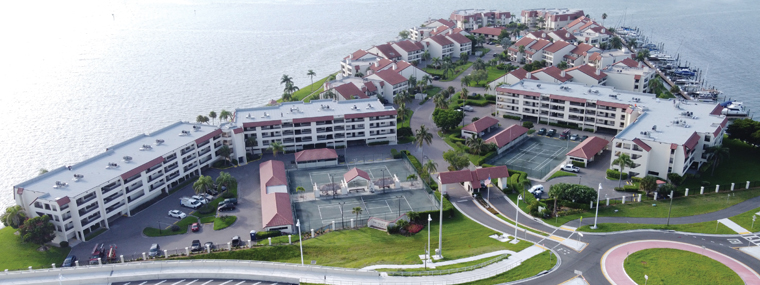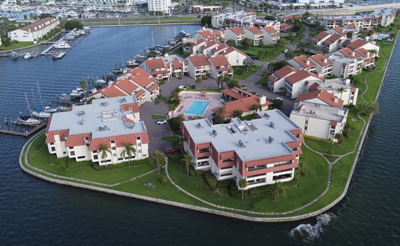
Don’t Ignore Your Roofing Needs
Budgeting and Having the Right Vendors are Vital
By Heather Vogt / Published February 2023

The Village at Tierra Verde in St. Petersburg, a well-established gated coastal condominium community, found itself in unfamiliar territory and perhaps in a situation other condominium and property owners can relate to. In conversations with their insurance consultant, they were told that the 40-year-old low-slope, built-up gravel over lightweight insulated concrete (LWIC) roofs on the four larger building units needed replacement within the next two years. The same was true for the steep-sloped decorative Spanish roof tiles over the gatehouse, carports, tennis court roofs, and mansards (a roof that has four sloping sides, each of which becomes steeper halfway down). Additional building code mandates also required the installation of hurricane stands for rooftop equipment (HVAC units).
The condominium board of directors took swift action to assemble a roofing committee. An aggressive but achievable timeline of one and a half years was set for the project. The well-organized condominium board had already been building its capital expense reserves, but it still found itself a bit underfunded in this market.
Board and roofing committee member Steve Sherry reminds other associations and property owners, “Budgeting is so important. If you have not updated your reserves established for roofing based on the remaining life span, you should do so immediately. Costs have changed (risen) significantly even in the last five years.”
Florida is experiencing a construction boom across all areas of commercial building and multifamily housing. You can couple that with material price increases and skilled labor shortages.
The roofing committee acted swiftly to hire a building envelope engineer (specialized in the design, inspection, and testing of all elements of the building), who proved to be a very valuable asset to the overall project. The engineer managed the full project, inspected it periodically, assured progress on payment was being met, and ensured steps were met to fulfill the warranty. With such a large investment being made to the property, selecting the proper roof system for the buildings along with a highly skilled and reputable contractor was vital to the roofing committee.
The roofing committee and engineer first discussed four roof system options:
- Built-up tar and gravel, the same as what they originally had—dismissed due to the cost.
- Spray polyurethane foam (SPF)—dismissed due to required maintenance (requires periodic re-coating).
- Thermoplastic Polyolefin (TPO) single-ply—dismissed for lack of desired longevity.
- SBS-modified bitumen multi-ply system—chosen for its overall high-wind strength, thickness, and longevity.
After researching and talking with four contractors, McEnany Roofing was chosen. The committee felt McEnany’s proven history from work on hospitals and schools around the area, the depth of skilled crew, and the commitment level they presented in their meeting made them the best fit. “They were not the cheapest of the contractors we looked at, but they looked the most committed. We couldn’t have been happier with the work they did and the overall project. They were great to work with,” says Sherry. This trust proved to be reciprocated by the roofing foreman and crew on the project.
McEnany immediately went to work and began ordering and pre-stocking materials so as to not delay the job when they started. It was a good thing they did; the preferred fastener was not available due to supply-chain issues. McEnany provided a change option and self-performed uplift testing to ensure that the solution met the high-wind design requirements. Roof core tests were performed and submitted to the engineer who confirmed the existing LWIC deck did not need to be replaced. More good news came when upon investigation it was revealed that a majority of the plywood behind the Spanish tiles was still good, saving on the project.
Once the project was up and going, it moved like a well-conducted symphony. The modified bitumen system was installed with cold adhesive and torched seams/end-laps on the granule-surfaced cap sheet. Installation of equipment supports and relocation of rooftop AC units were completed with minimal inconvenience to the occupants.
“Regarding the relocation of the HVAC equipment, units were only without air conditioning for one day, and there was very little interruption to the building residents,” said Sherry. New custom-fabricated flashings, drains, and dryer vents were also installed.
“McEnany has two metal shops with digital automated equipment and is certified and tested to make metals for high wind regions,” says Lance Manson, sales manager at McEnany Roofing. More savings came when McEnany devised the use of a rooftop-mounted crane to hoist the heavy Spanish tile up and down to the workers in the man lift (platform weight capacity of 300–500 lbs.) installing the mansards.
“Allowing the workers to occupy the lift only and prevent them from having to go up and down all day long reduced the price of the project substantially by reducing the man hours it would take to do the job,” says Manson. Because McEnany is also a general contractor, they were able to fix builder defects to the structure without stopping the project.
“I can’t say enough about the project crew from McEnany. They were courteous to residents while causing minimal inconvenience. Also, they were very respectful of the property by limiting the use of large cranes, putting plywood down under cranes that were used, replacing any turf damaged, and using metal detectors to ensure all screws and scraps were picked up,” commented Sherry.
The project engineer will continue to perform annual inspections moving forward. The Village at Tierra Verde is back to being insurance compliant and should not need to worry about its roof for years to come.
McEnany Roofing
McEnany Roofing is one of Florida’s premier commercial roofing contractors, with a multitude of satisfied customers. We are approved applicators for most commercial roof covering types, have several 20 to 30-year-old roofs still in place, and are held in high standing with manufacturers having a pre-approved contractor program. Having an ownership and management team with well over 100 years of experience in the industry gives our customers the security of knowing they are getting the quality they expect. For more information about McEnany Roofing, Inc., visit www.mcenanyroofing.com.







